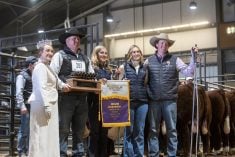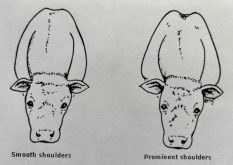Cattle producers often question semen evaluation forms for young bulls that report a lot of proximal and distal droplets.
They cause frustration because the bulls must be retested.
Droplets are probably the most common defect seen by veterinarians when performing breeding soundness exams in the spring.
We see more droplets on average in young immature bulls just reaching sexual maturity. They are less sexually active and droplets are a frequent occurrence, especially when the bulls are not housed close to cycling females.
Proximal droplets appear as a swelling at the junction of the head and tail of the sperm. Distal droplets appear farther down the tail.
Read Also

Body condition, nutrition and vaccination for brood cows
One of the remarkable events of the past century related to ranching has been the genetic evolution of brood cows….
It’s important to realize that all sperm start with a proximal droplet as they mature in the epididymis, the little knob at the bottom of the testicle. Generally the droplet is shaken down and eventually sloughed off as the sperm matures and wriggles its way through the canals of the epididymis. Sperm with droplets are essentially not mature so fertility is affected.
When we look at distal droplets there are essentially two types: those severely affected (pathologic) and those that will eventually be shaken off, producing a mature sperm cell (physiological).
Dr. Jacob Thundathil of the University of Calgary faculty of veterinary medicine found that the percentage of droplets in ejaculated sperm goes down as semen is chilled and ultimately frozen for artificial insemination. This takes about three hours.
If we assume the same thing happens in natural breeding as the sperm is swimming up the vagina and into the uterus a number of these distal droplets would be shaken off and left behind. As a result distal droplets are not as serious a defect as proximal droplets.
Samples with a large number of proximal droplets are often associated with other sperm defects such as deformed heads.
Droplets are usually the reason young bulls fail their first semen evaluation, especially if it is done at a young age. This is why we recommended beef bulls not be tested before a year of age (18 months for bison as they mature much later).
At 12 months old only half the bulls pass a semen test but that increases to 75 per cent by the time they are 14 to 15 months old. Many will pass only one or two months later.
From the Alberta Farmer Express website: Common pitfalls of semen evaluation
Unfortunately veterinarians can’t predict which ones will improve faster than others so the only thing to do is retest them. In my opinion you can speed up the process by housing these young bulls close to cycling females so they are encouraged to ejaculate their older semen.
Veterinarians document morphological defects on the semen form so you can follow any improvement over time. I remember one young bull that had nearly 100 per cent proximal droplets on the first test but the percentage kept dropping over the next several months until he eventually was producing excellent semen as a two year old. He was a show bull so the question always comes up, was he too fat, inactive etc.
When veterinarians encounter a lot of droplets in mature bull semen, which is rare, they usually assess the other defects to determine the overall prognosis, remembering that proximal droplets are a more severe defect that distal droplets that may be shed before the sperm contacts the egg.
If most of the defects in a young bull are distal droplets and he still passes his semen test, meaning defects overall are less than 30 per cent, then there is a very good chance those defects will lessen with maturity and usage.
Over the years bull sale dates have remained largely the same yet purebred producers are calving later which means veterinarians are testing younger and younger bulls.
If you are selling off the farm consider delaying the test until the bulls are as mature as possible. It is much better to evaluate bulls just over a year of age during warm spring weather with cows cycling nearby than in the dead of winter. Even one to two weeks older makes a big difference. The pass rate will be higher and it will be easier on everyone including the bulls.
Don’t ask your veterinarian to try evaluating bulls at less than one year of age. It’s to your benefit to wait, and the bulls.
















